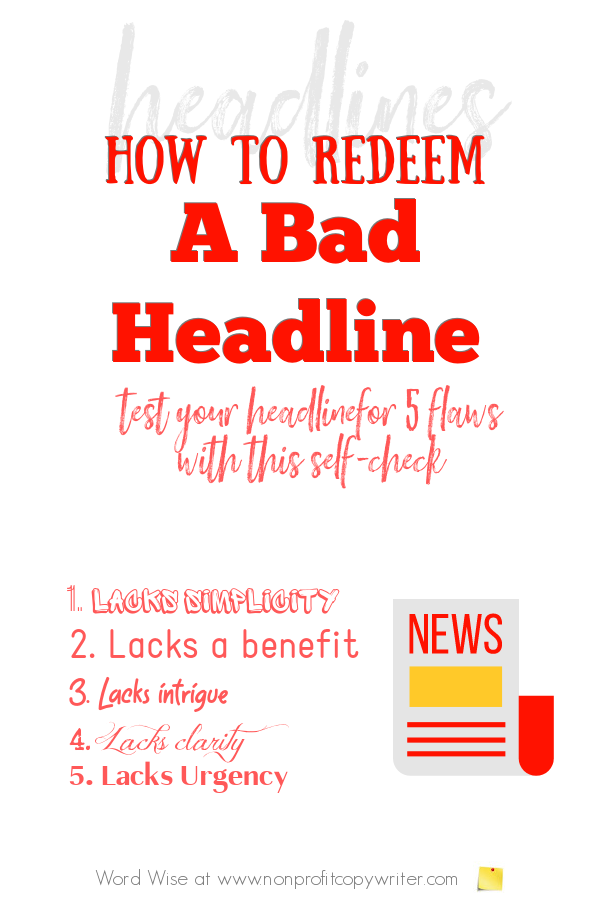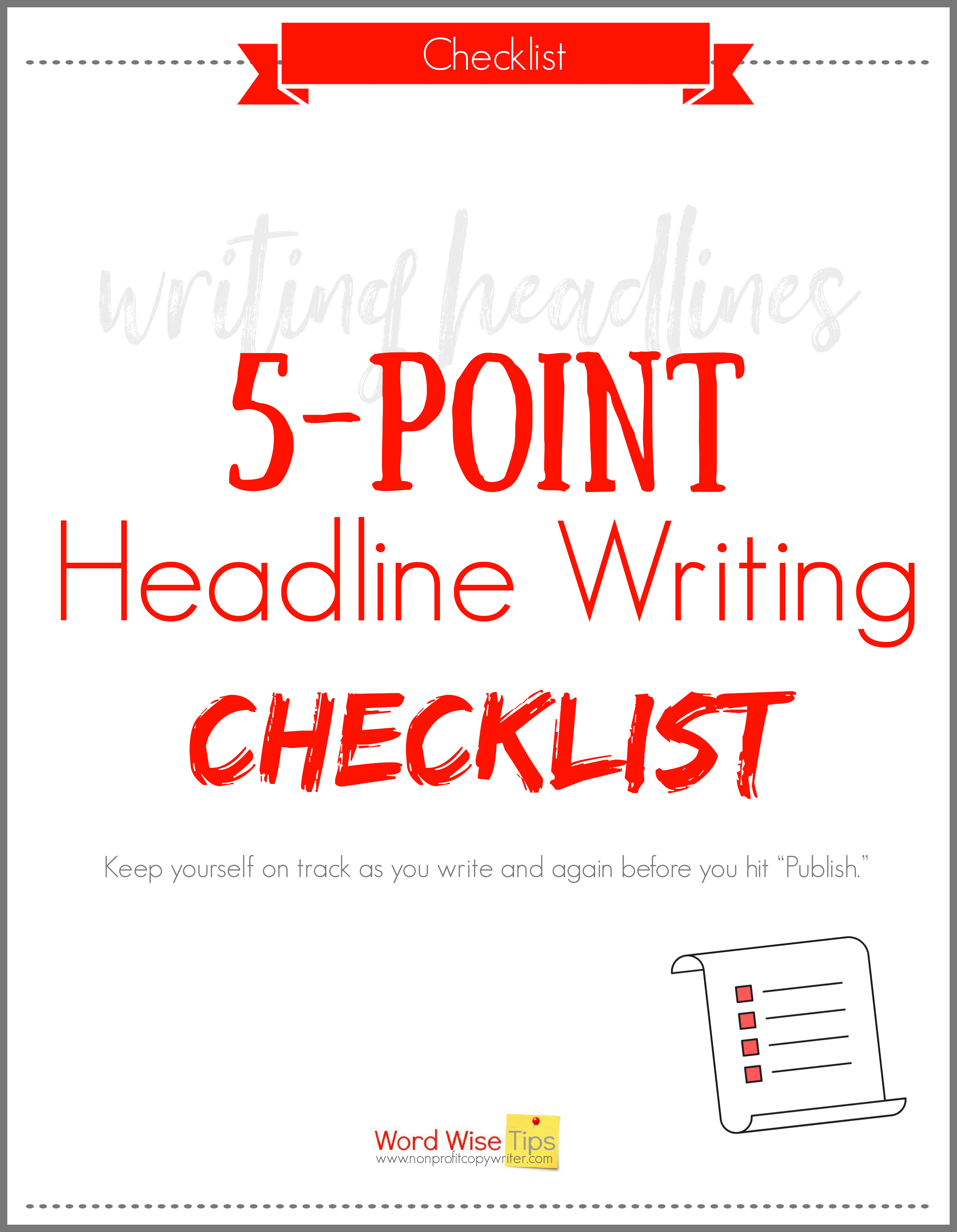Save Time: Get 5 Simple Writing Tips
you can put to use in 10 minutes
How to Redeem a Bad Headline
Award-winning writer Kathy Widenhouse has helped hundreds of nonprofits and writers produce successful content , with 750K+ views for her writing tutorials. She is the author of 9 books. See more of Kathy’s content here.
Updated 2.13.25
How can you know you’ve got a bad headline before you submit an article or publish a blog post or send your email newsletter? After the fact doesn’t help much. Your headline’s job is to pull in readers to the rest of your content. A bad one means fewer opens, less likes, zero comments…
Plenty of headlines don’t pass muster as a winner. “You can’t move two pages on the web without tripping across a poorly-crafted headline,” says Copyblogger’s Brian Clark. Like you, I shudder to think that mine are among those rejects.
Which explains why writing a good headline is among the most highly coveted skills in our writing arsenals. I write multiple headlines for each piece of content. Then I use two simple steps to eliminate the horrible ones and redeem others to ultimately find one to use. The process has become almost second nature to me.
Take two steps to fix a bad headline
Step 1: Identification. Before you can fix a problem, you need to know what the problem is. At least 5 flaws contribute to a bad headline. I run my headlines through a simple self-check (below) to see if they’re deficient in three or more of these areas.
Step 2: Repair. I’ve learned how to fix those specific problems so I can redeem a bad headline. You can too.
Test your headline with this self-check
Here are five of the most urgent headline shortcomings. By way of example, you can see an actual bad headline that landed in my inbox or on my search engine feed that demonstrates each particular headline flaw. And I give you some ways you can redeem those headline flops so they become all-stars and pull plenty of readers into your content.
Headline flaw #1: A bad headline is vague
Actual headline example: “Can You Help?”
A good headline is specific, rather than general. I’m all for question headlines, but this example is ambiguous at best. The question, “Can You Help?” could beg for support for an upcoming Girl Scout cookie sale … a request for cruising tips in the Adriatic … intervention in a troubled marriage … or the solution for an HTML coding snafu. A bad headline, like this one, is vague.
You can tell your headline is wishy-washy if any of these apply:
- The headline is relevant to multiple situations across multiple genres.
- The headline lacks descriptive verbs and relies on “be” verbs or nondescriptive verbs.
- The headline asks a question that anyone can answer.
You can redeem a vague headline by …
- Targeting a specific audience, cause, or need.
- Asking a question that only a specific group of people or those with a specific problem can answer.
- Using active, descriptive verbs.
- Adding numbers or statistics to your headline.
Headline flaw #2: A bad headline lacks a benefit
Actual headline example: “It’s National Salad Month”
A good headline offers a benefit. But this headline example presents the simple fact that it’s Salad Month. It begs the question, So, what? How does that fact make a difference for you and me? In writing circles, this statement is called a feature — a raw observation, statistic, or piece of information that anyone can write about. Your headline may fall into the “bad” category when it offers only facts — features — rather than showing how those facts impact the reader.
In contrast, a benefit moves a step beyond features by spelling out what the facts can do for the reader. Benefit-oriented writing demonstrates that you understand the reader and her needs — and you offer help. As in, “It’s National Salad Month, and Here are 3 Ways You Can Get More Healthful Greens.”
You can redeem a feature-focused headline by …
- Listing all the benefits you offer in your content and choosing one to include in your headline.
- Answer the question, “So, what?” in your headline.
- Find a way to use “you” (or variations like yours or you’ll) in your headline to focus on the reader.
Headline flaw #3: A bad headline lacks intrigue
Actual headline example: “Expanding My Circle”
A good headline arouses curiosity. It hooks the reader by referencing a problem or question for which he wants answers — or addresses a challenge or difficulty with a unique angle.
This example headline, “Expanding My Circle,” is all about the writer. There’s no focus on the reader. Where’s the mystery or curiosity or even attempt to engage? Further, who cares about the writer’s circle? No more than one or two people (like her mother and her childhood BFF) want to know she’s letting more people into his revered clique.
You can redeem a boring headline by …
- Asking a question that’s pertinent to your target reader.
- Implying the solution to a problem that your reader cares about.
- Citing an intriguing statistic or fact and how it may impact the reader.
Headline flaw #4: A bad headline is confusing or complicated
Actual headline example: “Certified Prompt Engineer Access”
A good headline is clear and simple for the average reader. Remember, you have just a few seconds to grab a reader’s attention with your blog post headline, your eBook title, or your email subject line. Can an eighth-grader read and understand yours? If your answer is no, fix it.
As for this example, once I get past the first word in this headline, I’m in an abyss of mystery. I like the idea of certification because it implies credentials. But the rest of the headline confuses me. Does the content offer access to an engineer … explain how to become a certified engineer … tout the benefits of being married to an engineer … highlight the merits of prompt-based AI technology … list the different types of engineering for which you can get certified? If you’re not up-to-date with technology, you don’t know what to think.
You can redeem a confusing/complicated headline by …
- Using shorter words rather than long ones.
- Eliminating jargon.
- Reducing the number of words in your headline.
- Testing your headline with a readability tool.
Headline flaw #5: A bad headline lacks urgency
Actual headline example: “XYZ Newsletter” (where XYZ refers to a business or organization)
A good headline indicates urgency. Does your headline reveal a deadline, a need, or a vulnerability, whether obvious or hidden?
This example headline offers nearly zero motivation for me to keep reading. There’s no limited-time offer … no need to engage right away … no sense of immediacy. Like you, I receive dozens of newsletters with headlines like these. And since there’s no urgency to read them, I am perfectly okay if these pieces of content remain in my inbox or on my scroll for days or weeks on end or even end up in the trash folder. Their headlines offer no compelling reason for me to gobble up the content right now.
Compare two different headlines: XYZ Newsletter and How to Redeem a Bad Headline. The first gives no nudge or press to read further. The second offers a subtle warning with a gentle press: your headline may be bad, but you can fix it. You better read further (as you have done) to find out what the problem is and how to rectify it as soon as possible.
You can create urgency in an apathetic headline when you …
- Use time-related words like now, hurry, deadline, ASAP, or immediate.
- Create scarcity. Show that just 100 spots are available or that very few people will take a certain step.
- Point out a problem, warning, risk, or danger. You needn’t be a Negative Nellie. Just present the reader’s vulnerability and promise a positive solution.
Get your own copy of the checklist for FREE.
Identify and fix your bad headline
When a headline meets all five criteria, I clearly have a winner. If I hit four, I’m satisfied. When three of the five are present, I poke around a bit to strengthen a so-so headline until it becomes compelling. If just one or two of these benchmarks show up in my headline, I rewrite it.
I’ve yet to find a bad headline that is beyond redemption after a bit of work.
Now that you have the tools to rescue your wayward headlines, use them to identify what makes a headline a dud. And then, take steps to redeem yours and transform it into an engaging hook that pulls readers into your content.
More Headline Writing Tips
Top 12 Headline Templates and Why They Work ...
Does your headline do its job?
Write Great Headlines With One Simple Formula ...
Try these 5 proven headline formulas ...
How to Write How-To Headlines That Pull in More Readers ...
The SELWAB Formula: great for writing leads and headlines ...
7 Tips for Using Numbers in Headlines ...
10 words to use when writing headlines ...
When Do Question Headlines Work?
See more tips on our Writing Headlines Pinterest board...
As an Amazon Associate I earn from qualifying purchases.
Share This Page

Named to 2022 Writer's Digest list
BEST GENRE/NICHE WRITING WEBSITE


Stop Wasting Time!
Grab your exclusive FREE guide, "5 Simple Writing Tips You Can Put to Use in 10 Minutes or Less"













